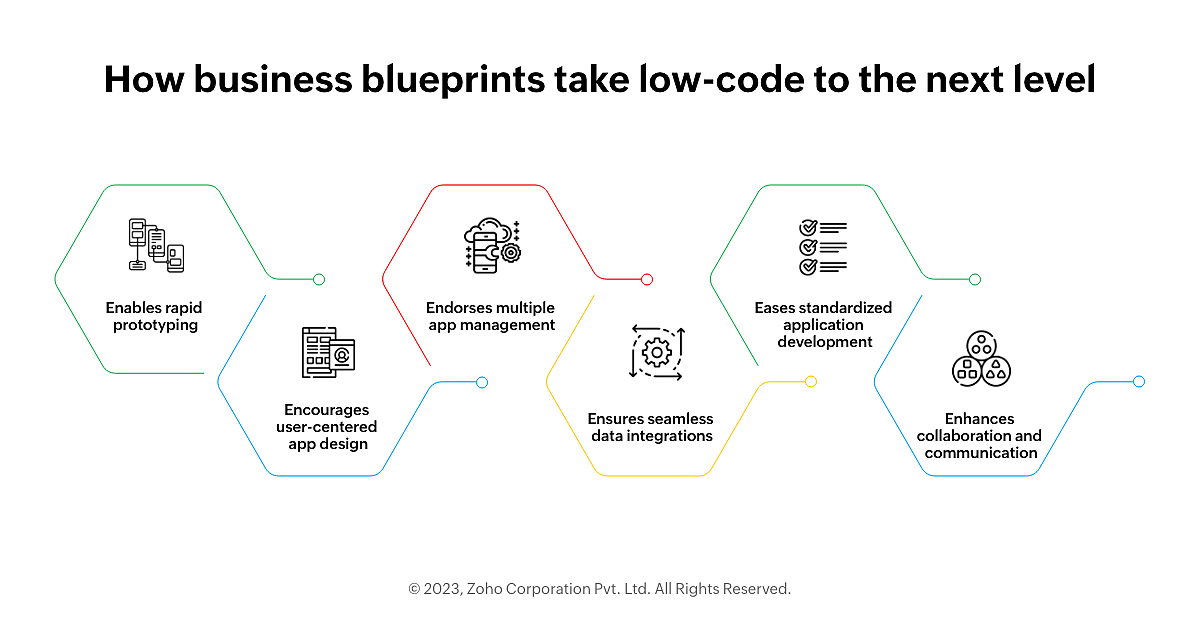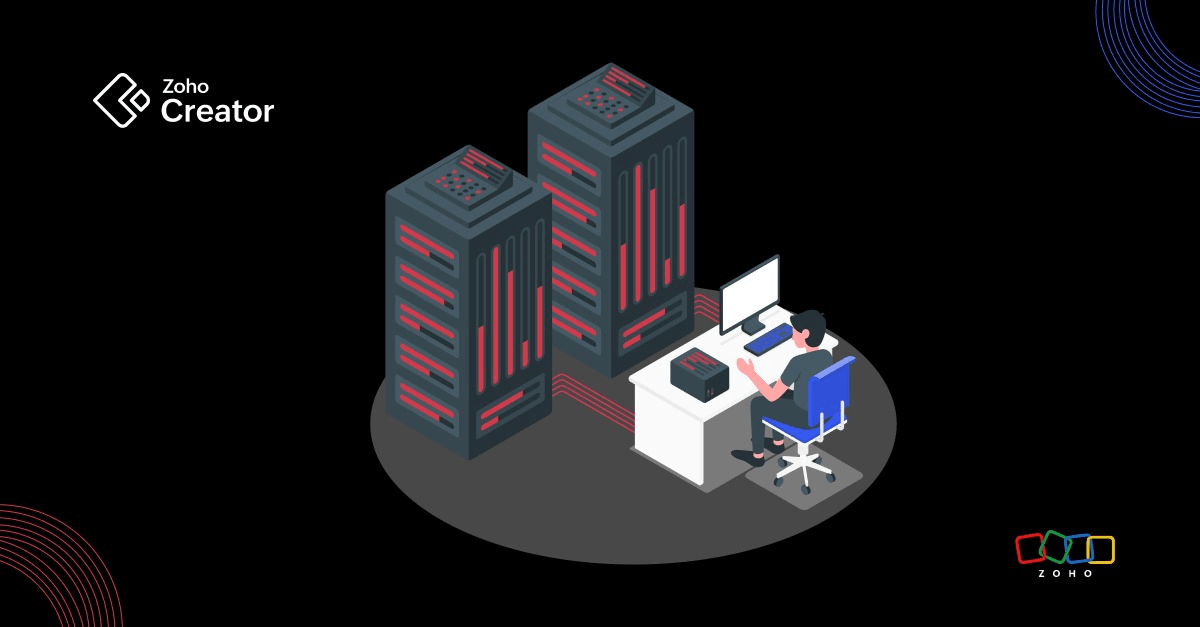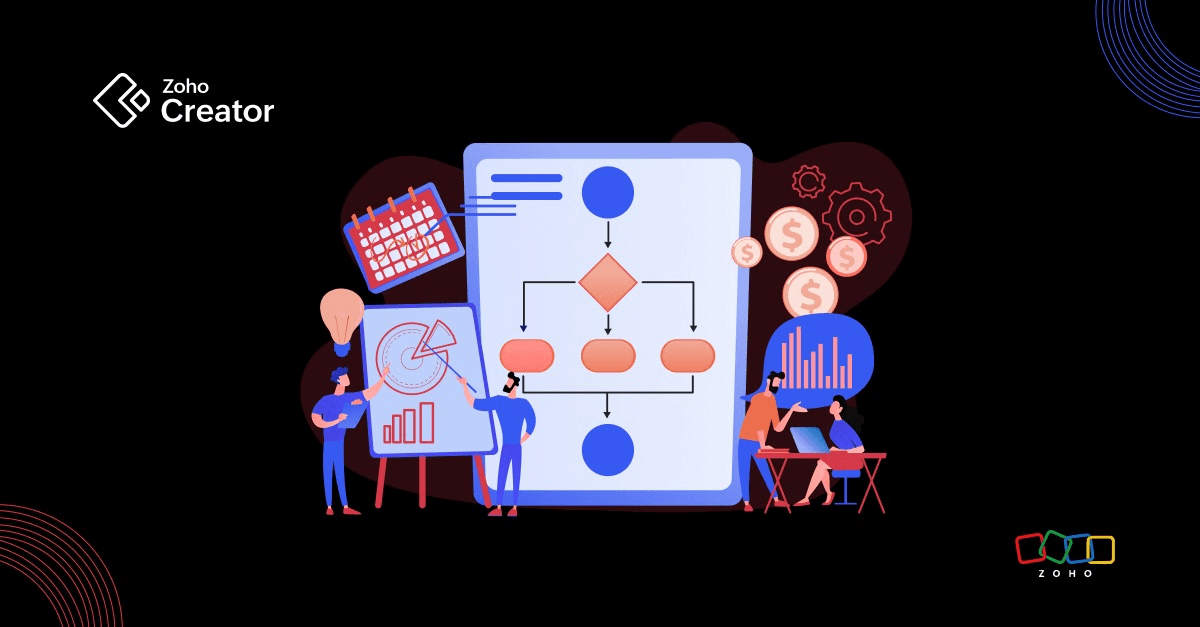- HOME
- Know Your Tech
- 6 ways business blueprints can supercharge low-code application development
6 ways business blueprints can supercharge low-code application development
- Last Updated : October 26, 2023
- 611 Views
- 10 Min Read
In the sphere of low-code application development, a business blueprint serves as a crucial tool that provides a detailed, visual representation of the business process requirements of the organization. It’s akin to a roadmap that guides developers through the course of application development, ensuring alignment with the business' strategic goals and objectives.
Low-code methodologies, as the name indicates, minimize the effort and complexity of traditional coding. By using visual interfaces and drag-and-drop components, low-code platforms empower developers to create applications rapidly, without the need for extensive hand-coding. This framework democratizes app development, enabling even non-technical users to contribute meaningfully to the creation of business applications.
A business blueprint comes into play as a guiding document that outlines the business processes, scenarios, and requirements to be addressed by the low-code application. It lays out the “what” and the “why” of the application, clearly identifying the business problems to be solved and the desired outcomes. This way, developers, irrespective of their technical know-how, can focus on the “how,” i.e., creating the most effective application using low-code methodologies that address the outlined business needs.
Understanding the business blueprint and its importance in low-code application development methodologies
A business blueprint serves as a comprehensive document containing all of the information related to the application, including its purpose, various features and functions, user interface design elements, workflows, security protocols, and data integration points. It allows developers to see the entire picture of the project, and identify potential opportunities for improvement in terms of performance or efficiency.
This blueprint also helps in understanding how the application is going to be used by its end-users. It allows developers to develop an intuitive user experience that meets users' expectations and facilitates a smooth flow of work within the business organization. This makes it much easier for developers to create applications with low-code methodologies because they can refer back to the blueprint at every stage of application creation.
Another major benefit of using a business blueprint in low-code application development is the fact that it serves as a single source of truth for all stakeholders involved in the process. With a well-defined blueprint in place, developers can ensure that their applications meet business requirements consistently and accurately across different departments and teams. As such, it helps save considerable amount of time and energy typically spent on back-and-forth conversations between the development team and other stakeholders.
Benefits of using a business blueprint
- Reduces development time.
- Improves the quality of the application.
- Enhances collaboration between developers and business stakeholders.
- Lowers the costs of app development.
- Ensures greater accuracy and faster implementation.
- Encourages rapid prototyping to identify issues earlier in the process.
- Enhances the user experience with intuitive interface design elements.
- Provides a platform for developers to collaborate and share ideas.
- Simplifies the development process by reducing manual coding efforts.
- Streamlines the process of integrating multiple applications into a single platform.
- Increases agility by allowing development teams to quickly respond to changing business needs.
- Improves scalability with simpler rules and workflow management.
- Allows developers to easily share, review, and modify applications as required.
Use case 1: Rapid prototyping
A business blueprint is a powerful tool that can truly revolutionize the way we prototype applications. So let's dive into one of the most exciting aspects of using a business blueprint in low-code application development: rapid prototyping.
First, let's define what we mean by rapid prototyping. In simple terms, it's the process of quickly creating a simplified version of a product or application to test its functionality and user experience before investing significant time and resources into building the final product. Now, let's talk about how using a business blueprint aids in this process.
One of the most significant benefits of using a business blueprint is that it enables developers to capture business requirements and processes quickly and efficiently. This means that instead of spending weeks or even months interviewing stakeholders and composing lengthy requirement documents, developers can use a business blueprint to streamline the process and capture everything in just a few days.
This faster requirement gathering process leads to quicker prototyping because developers can immediately start building small prototypes of the application using the information they gathered in the business blueprint. These prototypes can then be used to test the functionality of the application and get immediate feedback from stakeholders. Any necessary changes or revisions can be made right away, rather than waiting for weeks to get feedback on a fully developed application.
Another way in which a business blueprint helps in rapid prototyping is by allowing developers to create low-fidelity wireframes quickly. This means that developers can create simplified versions of the application's user interface, which can be used to test the application's usability and user experience. Within these wireframes, developers can also add simple logic and connections to demonstrate how the application functions.
Finally, a business blueprint helps developers prototype applications quickly by facilitating collaboration between stakeholders. A business blueprint's visual nature and simple language makes it easy for stakeholders to get involved in the application development process. This increases the number of perspectives on the project and helps to create an application that meets the needs of all stakeholders.
Use case 2: User-centered application design
Have you ever used an application that left you feeling frustrated and confused? Maybe you're a developer who has received negative feedback from users about the functionality of an app you created. This is where user-centered design, also known as human-centered design, comes into play.
In simple terms, user-centered design is the process of designing an application with the end-user in mind. This means putting yourself in their shoes, understanding their needs and preferences, and creating an application that meets those needs. But how does using a business blueprint fit into this process?
Having a business blueprint helps developers understand the business context in which the application will be used. This will help them create a design that is both intuitive and functional. With this approach, developers work in a way that ensures that the application is not only easy to use, but it also aligns with the business objectives.
One of the key benefits of using a business blueprint in user-centered application design is the ability to predict what users want, need, and expect from an application. It helps developers identify potential problem areas and find solutions before the application is built. This saves time and resources while also delivering an application that meets the needs of its users.
Additionally, using a business blueprint allows developers to create a data model that accurately represents the business, making sure that the application is both functional and accurate. This helps create a better user experience by making sure that the data being used in the application is reliable and up-to-date.
Use case 3: Managing multiple applications
When it comes to managing multiple applications in low-code development, a business blueprint holds a crucial place. It enables developers to create a blueprint of the entire business process, which includes interaction with multiple applications, dependencies, and relevant workflows. When multiple applications are integrated within a single low-code development framework, managing them can get extremely complicated. The business blueprint eliminates this complexity by laying out the overall process, which can be easily followed and executed.
Having a business blueprint provides a comprehensive view of the various applications involved in the business process, and how they interact with each other. It gives developers a clear idea of what needs to be done, in what order, and how it impacts different applications. This allows developers to map the workflow efficiently, which in turn leads to better project management, reduced development time, and improved quality.
Moreover, the blueprint serves as a reference point for all stakeholders involved in the development process, including clients, business analysts, developers, and testers. It ensures that everyone is on the same page and aware of what needs to be done, reducing the chances of miscommunication and errors.
Another advantage of using a business blueprint to manage multiple applications is that it allows developers to identify and rectify potential issues in advance. As the blueprint clearly defines the workflow, it becomes easier to identify any potential roadblocks or challenges that may arise while integrating various applications. This enables developers to take corrective measures in advance, minimizing the risk of project delays or failures.
Use case 4: Data integration
As you might already know, data integration is a crucial aspect of low-code application development. And when it comes to ensuring seamless integration of data across various business processes and applications, using a business blueprint can prove to be a game-changer.
So, how exactly does a business blueprint help in data integration? It plays a critical role in several ways. Let's take a closer look:
- It defines data requirements: Essentially, a business blueprint documents all of the data requirements for a given process or application. This includes identifying the various data sources, data types and formats, data mappings, and data flows across various systems. By doing so, it ensures that all of the data integration needs are clearly defined upfront, saving time and effort in the long run.
- It standardizes data formats: When dealing with data from disparate sources, standardizing data formats becomes a crucial requirement. A business blueprint provides a standardized data model that acts as a reference for all data integration activities. This ensures that all data is consistently formatted, making it easier to integrate with other systems.
- It facilitates data mapping: Mapping data across different systems can be a tedious and error-prone task. However, with a business blueprint, you can easily map data elements across various systems using a graphical interface. This not only reduces the chances of errors, it also speeds up the development process.
- It ensures data quality: Finally, a business blueprint helps ensure data quality by defining data validation rules, data cleansing requirements, and data privacy policies. This improves the accuracy and reliability of the data, which is crucial for the success of any low-code application.
Use case 5: Standardizing application development
So, you may be wondering: How exactly does a business blueprint help in standardizing application development? Well, let me tell you, it does wonders!
First, a business blueprint serves as a detailed guide that outlines a company's processes, workflows, and requirements. This means that the blueprint ensures that all parties involved in the development process—from developers to business analysts to stakeholders—are aligned on the project's vision, scope, and objectives.
This standardization is achieved by creating a centralized repository of all the information related to the project. This repository contains everything from the project's scope and stakeholders to the business rules and requirements. By having all of this information in one place, the development team can easily reference the blueprint and ensure that they’re working towards the same goal.
Furthermore, because the business blueprint is a living document, it allows for ongoing project management, monitoring, and reporting. This means that as the project progresses, the development team can use the blueprint to track their progress, identify any deviations from the original plan, and make necessary adjustments.
The business blueprint plays a vital role in standardizing application development. By creating a centralized repository for all of the project's information, and ensuring that all parties involved are aligned towards the same goal, the blueprint helps ensure the project's success. It's an invaluable tool in low-code application development methodologies, providing a detailed understanding of project requirements to ensure that the solution ultimately meets business needs.
Use case 6: Enhancing collaboration and communication
As we dive deeper into the use cases of business blueprints in low-code application development methodologies, it’s important to highlight one of its key benefits: enhancing collaboration and communication.
But how exactly does a business blueprint achieve this?
With a business blueprint, there’s no need for lengthy email exchanges or confusing conference calls. Instead, stakeholders can simply refer to the business blueprint to get the information they need. This not only saves time, it ensures that everyone is on the same page, reducing the risk of miscommunication.
Moreover, having a business blueprint in place allows for greater collaboration because it encourages different teams to work together to achieve the common goal. This means that developers, analysts, and business experts can all come together to ensure that the project is executed to perfection.
In fact, a business blueprint can even act as a collaborative tool itself, allowing multiple users to work on the same document simultaneously. This feature is especially useful in remote work settings, where face-to-face collaboration opportunities may be limited.

Conclusion
In the world of low-code application development methodologies, the business blueprint plays a critical role in ensuring the success of any project. It serves as a roadmap that provides a detailed overview of the business requirements, objectives, and goals of the project. The blueprint helps define the scope of the project and ensures that all stakeholders involved have a clear understanding of what they want to achieve.
One of the significant benefits of using a business blueprint in low-code application development is that it reduces the risks involved in the project. Because it lays out the scope and requirements of the project, it helps in identifying potential challenges that may arise during the development process. This, in turn, helps developers plan and prepare accordingly and avoid potential roadblocks.
The business blueprint also helps ensure a high level of collaboration between all stakeholders involved in the project. Because it's a detailed document, it provides a common ground for everyone to work from and helps in aligning everyone's understanding and expectations. This often leads to fewer conflicts and misunderstandings, which reduces the likelihood of project delays and failure.
Another noteworthy advantage of using a business blueprint in low-code application development is that it helps developers achieve better project outcomes. Because the blueprint provides a detailed plan and visual representation of what the project aims to achieve, developers can create more accurate time and cost estimates. They can also create an in-depth project plan, which makes it easier to monitor progress and ensure that the project is on track to meet its goals.
In conclusion, a business blueprint is a critical component of any successful low-code application development methodology. It helps reduce risks, improves collaboration, and ensures better project outcomes. By investing the time and resources to develop a comprehensive business blueprint, organizations can significantly increase their chances of success and achieve their desired project outcomes.
 Pranesh
PraneshPranesh is a serial entrepreneur and the Founder of Studio 31, a 12 year old, deep tech enabled, wedding photography and film company that has been recognized by many publications for its zero inventory model and unique culture in the unorganised sector.
Zoho Creator has helped Studio 31 redefine its business model by automating over 37 processes and save three hours every single day. He is also a growth consultant for Zoho Creator and helps the team address real-world challenges from a customer's point of view.



